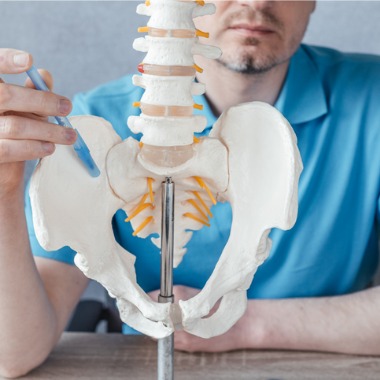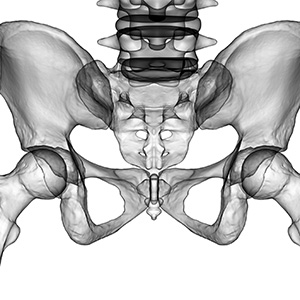Sacroiliac Joint Pain Relief Tips
Sacroiliac (SI) joint pain can be a frustrating and debilitating condition for those who suffer from it. It is often characterized by low back pain that radiates to the buttocks and thighs and can be caused by a variety of factors, including poor posture, pregnancy, and osteoarthritis. Fortunately, there are several ways patients may experience sacroiliac joint pain relief.

Sacroiliac (SI) joint pain can be a frustrating and debilitating condition for those who suffer from it. It is often characterized by low back pain that radiates to the buttocks and thighs and can be caused by a variety of factors, including poor posture, pregnancy, and osteoarthritis. Fortunately, there are several ways patients may experience sacroiliac joint pain relief.
8 Possible Ways to Reduce SI Joint Pain
Low back and SI joint pain may be either chronic or acute. Most cases of acute pain go away with time and self-care, while a more persistent form of SI joint pain may need professional treatment.
If you suffer from chronic pain, speak with a healthcare provider for a proper diagnosis and treatment plan, and always consult your doctor before starting any new exercise regimen.
The following are some possible tips for relieving SI joint pain:
1. Practice Good Posture
Maintaining good posture may help alleviate stress on the SI joints and reduce pain. This means standing up straight with your shoulders back and your feet shoulder-width apart. When sitting, keep your feet flat on the ground, and your knees bent at a 90-degree angle.
2. Try Cold and Heat Therapy
Cold and heat therapy are two simple, effective methods for relieving SI joint pain. Both can be used to reduce inflammation and alleviate discomfort.
Cold therapy, also known as cryotherapy, involves the use of cold packs, ice, or ice water to cool the affected area. Cold therapy is most effective at reducing inflammation and numbness in the first 48 to 72 hours after an injury. It can also help reduce muscle spasms and pain. To use cold therapy, wrap an ice pack or bag of frozen vegetables in a towel and apply it to the affected area for 15 to 20 minutes at a time, several times a day. Be sure to wrap the ice pack in a towel to protect your skin.
Heat therapy, also known as thermotherapy, involves the use of heat packs, hot water bottles, or heating pads to warm the affected area. Heat therapy can help increase blood flow to the affected area and relax muscles, which can reduce pain and stiffness.
To use heat therapy, apply a heat pack or hot water bottle to the affected area for 15 to 20 minutes at a time, several times a day. Use caution when applying heat, as applying heat for too long or at too high of a temperature can cause burns.
It is important to note that cold and heat therapy should not be used simultaneously, and it is generally recommended to start with cold therapy in the first 48 to 72 hours after an injury and then switch to heat therapy to help with muscle relaxation.
3. Consider Over-the-counter Pain Medication
Nonsteroidal anti-inflammatory drugs (NSAIDs) such as ibuprofen or aspirin can be effective at reducing inflammation and relieving pain. Be sure to follow the instructions on the label and consult with a healthcare provider before taking any medication.
4. Try Physical Therapy
Physical therapy may be very effective for relieving SI joint pain. A physical therapist is a trained healthcare professional who can develop a treatment plan specifically tailored to your needs. This may include exercises to strengthen the muscles around the SI joints, improve flexibility, and reduce pain.
In addition to exercises, a physical therapist may also use techniques such as massage or mobilization to help reduce pain and improve flexibility in the SI joints. It is important to follow the treatment plan provided by your physical therapist and to communicate any changes in symptoms or discomfort.
5. Practice Gentle Stretches
Gentle stretching exercises designed to target the affected muscles and ligaments around the SI joints may help improve flexibility and reduce pain.
6. Use a Supportive Cushion or Pillow
A supportive cushion or pillow may be an effective way to alleviate SI joint pain and improve comfort while sitting or sleeping. When sitting, using a lumbar roll or cushion helps maintain proper posture and reduce strain on the SI joints. These cushions are designed to support the natural curvature of the lower back and can be placed on a chair or in the car to provide added support.
In the bedroom, using a supportive mattress or pillow may help reduce pressure on the SI joints while sleeping. A firm or medium-firm mattress is generally considered the most supportive for those with SI joint pain. It is also important to use a pillow that supports the neck and head in a neutral position rather than one that is too high or too low.
It is important to note the type of cushion or pillow most effective for relieving SI joint pain may vary from person to person. It may be helpful to try a few different options and see which one provides the most comfort and support.
7. Avoid Activities That Exacerbate Your Pain
Certain activities, such as running or jumping, can put additional strain on the SI joints and cause pain. It may be helpful to avoid these activities or to take breaks and stretch frequently if you do engage in them.
8. Explore Alternative Therapies
Some patients find relief from SI joint pain through alternative therapies such as chiropractic care, acupuncture, or massage. It is always important to speak with a healthcare provider before starting any new treatment.
Discover LinQ for Sacroiliac Joint Pain Relief
The LinQ SI Joint Stabilization System provides patients with SI joint dysfunction with a minimally invasive option to combat their pain.
After a thorough diagnostic process, physicians may help alleviate, and in many cases eliminate, chronic pain by placing a single LinQ allograft into the affected SI joint. This single implant may help patients immediately regain joint stability – and with its large graft window, the LinQ helps create an ideal environment for long-term fusion.
If you suffer from chronic low back or SI joint pain, contact PainTEQ today to find a provider near you who offers LinQ. They will be able to evaluate your condition and determine if LinQ is a suitable treatment option for you.



